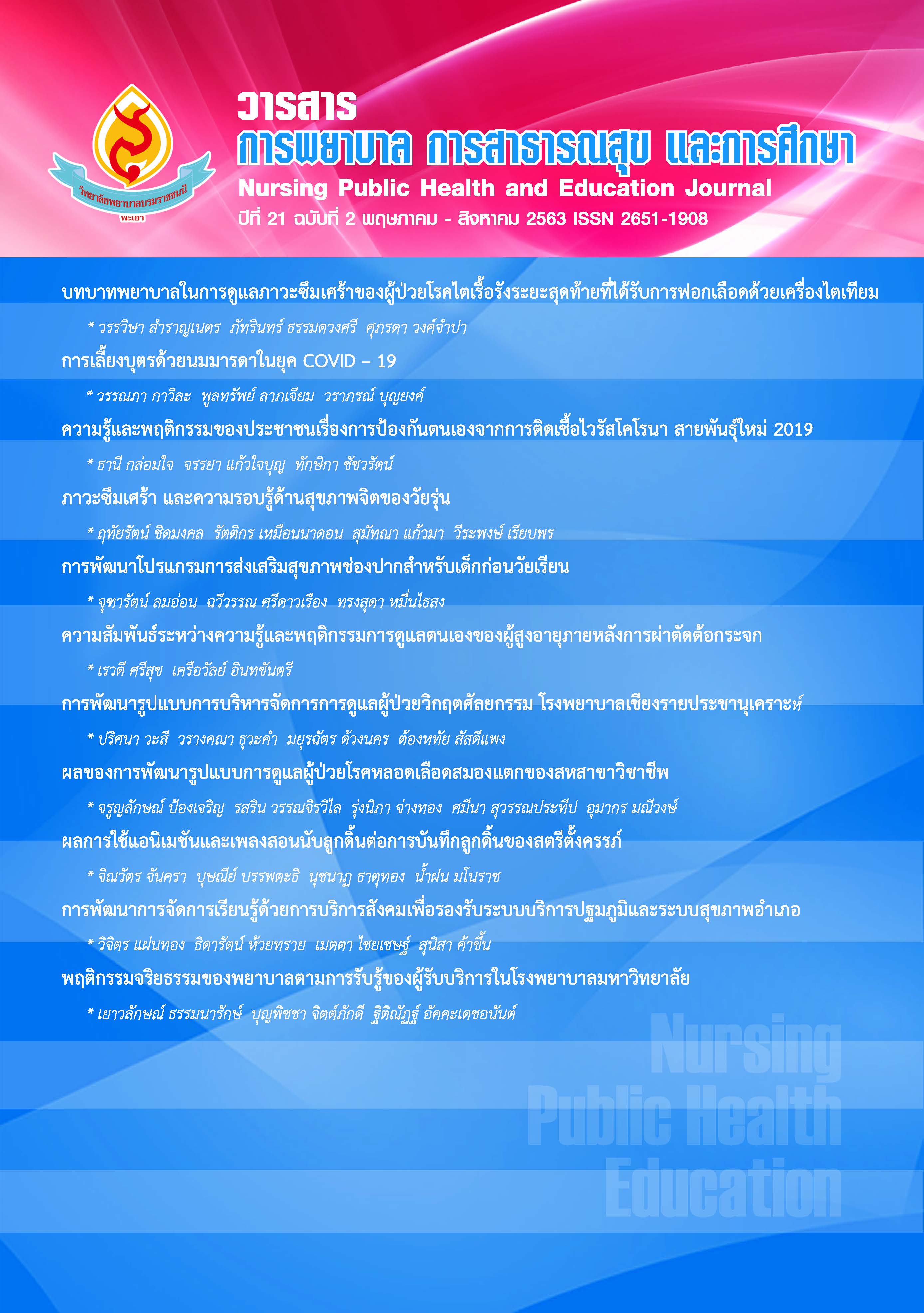ภาวะซึมเศร้า และความรอบรู้ด้านสุขภาพจิตของวัยรุ่น
คำสำคัญ:
ภาวะซึมเศร้าในวัยรุ่น, ความรอบรู้ด้านสุขภาพจิตบทคัดย่อ
การศึกษาเชิงพรรณนาครั้งนี้มีวัตถุประสงค์เพื่อสำรวจภาวะซึมเศร้าและความรอบรู้ด้านสุขภาพจิตของวัยรุ่นในเขตอำเภอเมือง จังหวัดอุดรธานี และเปรียบเทียบความรอบรู้ด้านสุขภาพจิตระหว่างวัยรุ่นที่มีภาวะซึมเศร้าและไม่มีภาวะซึมเศร้า กลุ่มตัวอย่างเป็นวัยรุ่น อายุ 15-19 ปี จำนวน 420 คน (ชาย 168 คน และหญิง 252 คน) จาก 6 โรงเรียน ในอำเภอเมือง จังหวัดอุดรธานี ปีการศึกษา 2562 ได้มาโดยการสุ่มแบบแบ่งชั้น เครื่องมือในการเก็บรวบรวมข้อมูล ได้แก่แบบคัดกรองภาวะซึมเศร้าในวัยรุ่น (CES-D) และแบบประเมินความรอบรู้ด้านสุขภาพจิตที่ผู้วิจัยพัฒนาขึ้น ซึ่งมีองค์ประกอบ 5 ด้าน ได้แก่ 1) ความรู้เกี่ยวกับการป้องกันการเจ็บป่วยทางจิต 2) การรับรู้ปัญหาสุขภาพจิตที่กำลังเกิดขึ้น 3) ความรู้ในการแสวงหาความช่วยเหลือและการรักษาที่มีอยู่ 4) ความรู้ในกลวิธีการช่วยตนเองเมื่อมีปัญหาเบื้องต้น และ 5) ทักษะการช่วยเหลือผู้มีปัญหาสุขภาพจิตเบื้องต้น ค่าความเชื่อมั่นของเครื่องมือแต่ละฉบับเท่ากับ 0.87 และ 0.92 ตามลำดับ วิเคราะห์ข้อมูลโดยใช้สถิติเชิงพรรณนา การทดสอบไคสแควร์ และการทดสอบทีแบบอิสระ ผลการวิจัยพบว่า (1) กลุ่มตัวอย่างมีภาวะซึมเศร้า 111 คน (26.43%) และไม่มีภาวะซึมเศร้า 309 คน (73.57%) โดยเพศหญิงมีภาวะซึมเศร้า 79 คน และเพศชายมีภาวะซึมเศร้า 32 คน ผลการทดสอบไคสแควร์พบว่าเพศหญิงมีภาวะซึมเศร้ามากกว่าเพศชายอย่างมีนัยสำคัญทางสถิต (X2=7.85; p =.006) (2) วัยรุ่นที่ไม่มีภาวะซึมเศร้ามีความรอบรู้ด้านสุขภาพจิตโดยรวมและรายด้านทุกด้านอยู่ในระดับมาก ส่วนวัยรุ่นที่มีภาวะซึมเศร้ามีความรอบรู้ด้านสุขภาพจิตโดยรวมอยู่ในระดับปานกลาง โดยมีด้านความรู้ในการแสวงหาความช่วยเหลือและการรักษาที่มีอยู่ ความรู้ในกลวิธีการช่วยตนเองเมื่อมีปัญหาเบื้องต้น และทักษะการช่วยเหลือผู้มีปัญหาสุขภาพจิตเบื้องต้นอยู่ในระดับปานกลาง ส่วนด้านความรู้เกี่ยวกับการป้องกันการเจ็บป่วยทางจิต และการรับรู้ปัญหาสุขภาพจิตที่กำลังเกิดขึ้นอยู่ในระดับมาก (3) การเปรียบเทียบความรอบรู้ด้านสุขภาพจิตระหว่างวัยรุ่นที่มีภาวะซึมเศร้าและไม่มีภาวะซึมเศร้า พบว่าวัยรุ่นที่มีภาวะซึมเศร้ามีความรอบรู้ด้านสุขภาพจิตโดยรวมน้อยกว่าวัยรุ่นที่ไม่มีภาวะซึมเศร้าอย่างมีนัยสำคัญทางสถิติ (t = 5.62; p =.000) เมื่อพิจารณาความรอบรู้ด้านสุขภาพจิตเป็นรายด้าน พบว่าวัยรุ่นที่มีภาวะซึมเศร้ามีความรู้เกี่ยวกับการป้องกันการเจ็บป่วยทางจิต ความรู้ในการแสวงหาความช่วยเหลือและการรักษาที่มีอยู่ ความรู้ในกลวิธีการช่วยตนเองเมื่อมีปัญหาเบื้องต้น และทักษะการช่วยเหลือผู้มีปัญหาสุขภาพจิตเบื้องต้นน้อยกว่าวัยรุ่นที่ไม่มีภาวะซึมเศร้าอย่างมีนัยสำคัญทางสถิติที่ระดับ .01
เอกสารอ้างอิง
กรมสุขภาพจิต. (2561). แนวทางการดูแลวัยรุ่นที่มีภาวะซึมเศร้า: Clinical Practice Guideline for Adolescents with Depression. กรุงเทพมหานคร: บัยอนด์ พับลิสชิ่ง จำกัด.
ขวัญเมือง แก้วดำเกิง. (2561). ความรอบรู้ด้านสุขภาพ เข้าถึง เข้าใจ และการนำไปใช้. กรุงเทพมหานคร: อมรินทร์พริ้นติ้งแอนด์พับลิชชิ่ง.
ขวัญเมือง แก้วดำเกิง. (2562). ความรอบรู้ด้านสุขภาพ ขั้นพื้นฐาน ปฏิสัมพันธ์ วิจารณญาณ. กรุงเทพมหานคร: อมรินทร์พริ้นติ้งแอนด์พับลิชชิ่ง.
ดวงใจ วัฒนสินธุ์. (2559). การป้องกันภาวะซึมเศร้าในวัยรุ่น: จากหลักฐานเชิงประจักษ์สู่การปฏิบัติ. วารสารคณะพยาบาลศาสตร์ มหาวิทยาลัยบูรพา, 24(1), 1-12.
บรรจง เจนจัดการ, จิณห์จุฑา ชัยเสนา ดาลลาส, และ ชนัดดา แนบเกษร. (2562). ปัจจัยทำนายภาวะซึมเศร้าของนักเรียนมัธยมศึกษาตอนปลายในเขตเทศบาลเมือง จังหวัดจันทบุรี. วารสารวิทยาลัยพยาบาลพระปกเกล้า จันทบุรี, 30(2), 62-75.
ฤทัยรัตน์ ชิดมงคล, พิมพ์วลัญชน์ อายุวัฒน์, และปรานต์ศศิ เหล่ารัตน์ศรี. (2562). ความรอบรู้ด้านสุขภาพจิตของนักเรียนชั้นมัธยมศึกษาตอนต้น โรงเรียนในเขตเทศบาลตำบลโนนสูง อำเภอเมือง จังหวัดอุดรธานี. วารสารการพยาบาล สุขภาพ และการศึกษา, 20(2), 35-42.
วิมลวรรณ ปัญญาว่อง, รัตนศักดิ์ สันติธาดากุล, และโชษิตา ภาวสุทธิไพศิฐ. (2563). ความชุกของภาวะซึมเศร้าและความเสี่ยงฆ่าตัวตายในวัยรุ่นไทย: การสำรวจโรงเรียนใน 13 เขตสุขภาพ. Journal of Mental Health of Thailand, 28(2), 136-149.
สำนักงานเลขาธิการสภาผู้แทนราษฏร. (2559, พฤศจิกายน 14). รายงานคณะกรรมาธิการขับเคลื่อนการปฏิรูปประเทศด้านสาธารณสุขและสิ่งแวดล้อม เรื่อง การปฏิรูปความรอบรู้และการสื่อสารสุขภาพ. สืบค้นเมื่อ 18 กุมภาพันธ์ 2563, จาก https://www.parliament.go.th/ewtadmin/ewt/parliament_parcy/download/usergroup_disaster/8-10.pdf
อุษณี อินทวรรณ, จิณห์จุฑา ชัยเสนา, และชนัดดา แนบเกษร. (2562). ปัจจัยทำนายภาวะซึมเศร้าของนักเรียนมัธยมศึกษาตอนต้น. วารสารกรมการแพทย์, 44(4), 125-131.
Attygalle, U.R., Perera, H., & Jayamanne, B.W. (2017). Mental health literacy in adolescents: ability to recognise problems, helpful interventions and outcomes. Child and Adolescent Psychiatry and Mental Health, 11(38). Doi: 10.1186/s13034-017-0176-1
Galambos, N.L., Leadbeater, B.J., & Barker, E.T. (2004). Gender difference in and risk factors for depression in adolescence: A 4-year longitudinal study. International Journal of Behavioral Development, 28(1), 16-25. DOI: 10.1080/01650250344000235
Gazmararian, J., Baker, D., Parker, R., & Blazer, D.G. (2000). A Multivariate Analysis of Factors Associated with Depression. Arch intern Med, 160(21), 3307-3314. DOI: 10.1001/archinte.160.21.3307
Graber, J. A., & Sontag, L. M. (2009). Internalizing problems during adolescence. In R. M. Lerner & L. Steinberg (Eds.), Handbook of adolescent psychology (3rd ed.). New York: Wiley
Hart, M.H., Morgan, A.J., Rossetto, A., Kelly, C.M., Mackinnon, A., & Jorm, A. (2018). Helping adolescents to better support their peers with a mental health problem: A Cluster-randomised crossover trial of teen Mental Health First Aid. Australian & New Zealand Journal of Psychiatry, 52(7), 638-651.
Johns Hopkins Medicine. (2020). Adolescent Depression in Awareness Program (ADAP). Retrieved April 20, 2020, from https://www.hopkinsmedicine.org/psychiatry/specialty_areas/moods/ADAP/
Jorm, A. F. (2011). Mental Health Literacy: Empowering the Community to Take Action for Better Mental Health. American Psychologist, 31, 1-13. DOI:10.1037/a0025957
Kutcher, S., Wei, Y., & Coniglio, C. (2016). Mental Health Literacy: Past, Present, and Future. Canadian Journal of Psychiatry, 61(3), 154-158.
Nolen-Hoeksema, S., & Girgus, J.S. (1994). The emergence of gender difference in depression during adolescence. Psychological Bulletin, 111(3), 424-443. DOI: /10.1037/0033-2909.115.3.424
Nutbeam, D. (2000). Advancing health literacy: a global challenge for the 21st century. Health Promotion International, 15(3), 183-184.
Stirling, K., Toumbourou, J.w., & Rowland, B. (2015). Community factors influencing child and adolescent depression: A systematic review and meta-analysis. Australian & New Zealand Journal of Psychiatry, 49(1), 869-886. DOI: 10.1177/0004867415603129
Tay, J.L., Tay, Y.F., & Klainin-Yobas, P. (2018). Mental health literacy levels. Archives of Psychiatric Nursing, 32(2018), 757-763. DOI: https://doi.org/10.1016/j.apnu.2018.04.007
Thapar, A., Collishaw, S., Pine, D.S., & Thapar, A. (2012). Depression in adolescence. Seminar, 379(9820), 1056-1067. DOI:10.1016/S0140-6736(11)60871-4
United Nations Children's Fund Thailand. (2016). A Situation Analysis of Adolescents in Thailand 2015-2016. Bangkok: UNICEF Thailand.
World Health Organization (WHO). (2019, October 23). Adolescent mental health. Retrieved January 24, 2020, from https://www.who.int/news-room/fact-sheets/detail/adolescent-mental-health
World Health Organization (WHO). (2014). Adolescence: a period needing special attention. Retrieved January 24, 2020, from https://apps.who.int/adolescent/second-decade/section2/page1/recognizing-adolescence.html
ดาวน์โหลด
เผยแพร่แล้ว
รูปแบบการอ้างอิง
ฉบับ
ประเภทบทความ
สัญญาอนุญาต
ลิขสิทธิ์ (c) 2020 วารสารการพยายาล การสาธารณสุข และการศึกษา

อนุญาตภายใต้เงื่อนไข Creative Commons Attribution-NonCommercial-NoDerivatives 4.0 International License.



